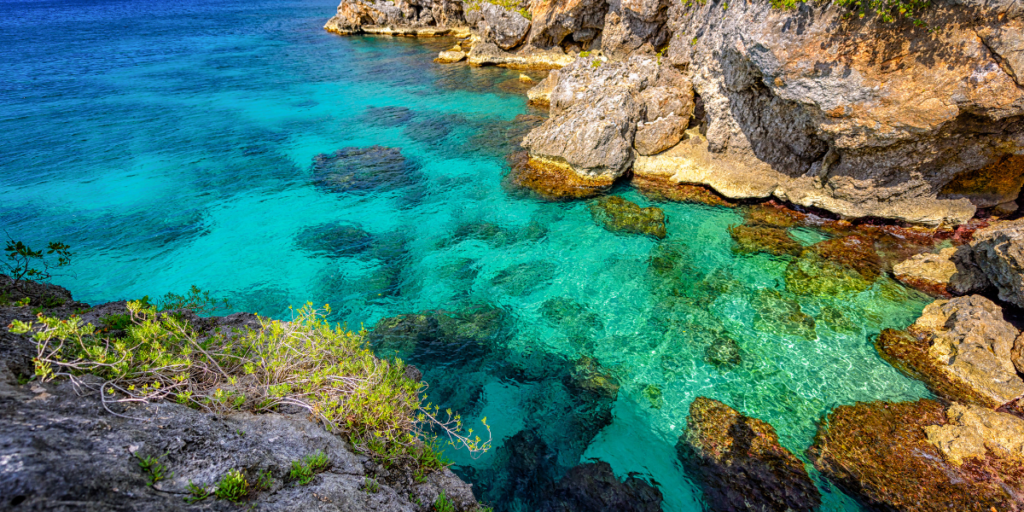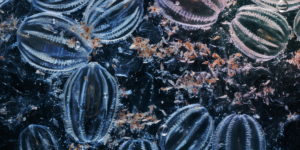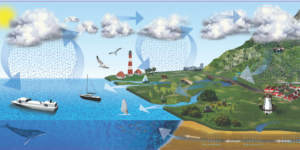Unveiling the Importance of Upwelling: Sustaining Vibrant Ocean Ecosystems
You may not realize it, but the health of our ocean ecosystems is inextricably linked to a natural phenomenon known as upwelling. While this term may not be familiar to many people, it plays a critical role in sustaining life beneath the surface of the ocean.
Upwelling occurs when cold and nutrient-rich water from deep within the ocean rises to the surface, providing essential nutrients for phytoplankton and other organisms at the base of the food chain.
Without upwelling, marine ecosystems would struggle to survive. The effects of its absence are already being felt around the world, with declines in fish populations and disruptions to entire food webs.
As such, understanding how upwelling works and why it is so important is key to preserving our oceans for future generations. In this article, we will explore the science behind upwelling, examples of regions where it occurs, and most importantly – why protecting and preserving these areas is crucial for maintaining healthy ocean ecosystems.
Key Takeaways
- Upwelling brings essential nutrients to the surface for phytoplankton and other organisms at the base of the food chain, making it crucial for maintaining healthy ocean ecosystems.
- Upwelling zones produce approximately 50% of the world’s total marine fishery yields, highlighting its importance for supporting diverse marine life forms.
- Pollution, overfishing, and climate change are posing significant threats to upwelling zones, putting the health of our oceans and marine life at risk.
- Conservation and management efforts such as marine protected areas, sustainable fishing practices, pollution control measures, and ecotourism can help mitigate these threats and preserve upwelling zones for future generations.

What is Upwelling?
You might be wondering, what’s upwelling and how does it affect ocean ecosystems? Well, let me tell you – upwelling is when cool nutrient-rich water rises from the depths of the ocean towards the surface!
This process occurs due to ocean circulation patterns and winds that push surface waters away from coastlines. As a result, deeper waters are forced to rise and replace the displaced surface water.
Upwelling plays a crucial role in maintaining healthy ocean ecosystems because it brings nutrients from deep waters to the surface. These nutrients include nitrogen, phosphorus, and iron which are essential for phytoplankton growth.
Phytoplankton form the base of many marine food webs and their abundance can support higher trophic levels such as fish populations. Additionally, upwelling can also increase dissolved oxygen levels in surface waters which supports aerobic organisms like fish and other marine animals.
Therefore, understanding upwelling is important for predicting changes in marine productivity and managing fisheries resources sustainably.
The Science Behind Upwelling
Like a deep breath of fresh air, upwelling mechanisms play a crucial role in maintaining the health of marine ecosystems. Upwelling brings nutrient-rich waters from the ocean depths to the surface, where they can be readily accessed by phytoplankton and other primary producers. These microscopic organisms form the base of the food web, providing sustenance for larger organisms such as zooplankton, fish, and marine mammals.
The impact of upwelling on marine biodiversity is significant. It creates ideal conditions for plankton growth and reproduction, which in turn supports higher trophic levels in the food chain. The nutrients brought up from deeper waters also promote coral reef growth and enhance overall ecosystem productivity.
Without upwelling, many marine species would struggle to survive due to limited access to nutrients and decreased prey availability. Therefore, understanding the science behind upwelling is essential for effective management and conservation efforts aimed at protecting our oceans’ health and diversity.
Upwelling and Productivity
When you consider the role of upwelling in maintaining healthy ocean ecosystems, it’s important to understand how it impacts phytoplankton growth.
Upwelling brings nutrients from deeper waters to the surface, providing an abundance of food for these tiny organisms.
As a result, upwelling plays a crucial role in the ocean food chain, as phytoplankton are the base of many marine food webs.
Understanding this connection is key to preserving these complex and fragile ecosystems.
Role in Phytoplankton Growth
As the ocean currents bring up cold, nutrient-rich water from the depths, phytoplankton thrive and form the base of a healthy marine food chain. Upwelling plays a crucial role in phytoplankton growth by increasing nutrient availability in surface waters.
Phytoplankton biomass is directly dependent on nutrient supply, particularly nitrate and phosphate concentrations. Studies have shown that areas with frequent upwelling events exhibit higher levels of primary productivity compared to regions without significant upwelling.
In fact, upwelling zones produce about 50% of the world’s total marine fishery yields due to their high concentration of nutrients and subsequent support for diverse marine life forms. Therefore, it’s clear that upwelling has a cascading effect on ocean ecosystems as it supports not only phytoplankton but also zooplankton, fish populations, seabirds, and even whales.
Ultimately, understanding the role of upwelling in maintaining healthy ocean ecosystems is critical for conservation efforts and sustainable fisheries management practices.
Connection to Ocean Food Chain
The interconnectedness of marine life is exemplified by the crucial link that upwelling plays in sustaining a diverse and productive food chain. Upwelling brings nutrient-rich waters from deep ocean layers to the surface, providing for phytoplankton growth and stimulating productivity at each trophic level.
The ocean food chain is characterized by different trophic levels, which represent feeding positions within the ecosystem. This complex network of interactions starts with primary producers, such as phytoplankton and seaweed, then moves on to herbivores, small fish, large predators, and eventually apex predators.
Upwelling supports all these trophic levels by supplying nutrients to support primary production. Phytoplankton are at the base of this food chain as they convert sunlight into chemical energy through photosynthesis. As a result of upwelling-induced phytoplankton growth, there is enough biomass for zooplankton (herbivores) to thrive upon.
Zooplankton serves as an important source of energy for small fish like anchovies or sardines (primary consumers). Small fish account for a significant portion of commercial fisheries worldwide and provide vital nutrition for larger predatory species such as tuna or sharks (secondary consumers).
Without upwelling stimulating primary productivity in the ocean’s ecosystems, many marine organisms wouldn’t have enough food sources to support their populations. This could lead to severe ecological consequences like population crashes or even extinction events.
Examples of Upwelling Regions
You can’t talk about upwelling without mentioning the mind-boggling productivity of regions like the Humboldt Current off the coast of South America or the Canary Current in Africa. These areas are not only some of the most productive ecosystems on Earth, but they also support a large portion of global fisheries and provide tourism opportunities.
The Humboldt Current, for example, is responsible for nearly 20% of global fish catch and supports important commercial species such as anchovy, hake, and sardines. However, fishing impacts have been a concern for this region due to its high levels of productivity.
On the other hand, the Canary Current provides important habitat for marine mammals and sea turtles, attracting tourists who seek out these unique wildlife experiences. Upwelling in these regions plays a crucial role in maintaining healthy ocean ecosystems that support both human livelihoods and biodiversity.
The Importance of Protecting and Preserving Upwelling
As you delve deeper into the topic of upwelling, it’s essential to understand the threats that these regions face and why conservation efforts are crucial.
Pollution, overfishing, and climate change are some of the significant challenges that upwelling areas encounter.
To preserve these critical ecosystems, management initiatives must be implemented to ensure sustainable practices are followed by stakeholders.
Threats to Upwelling Regions
Unfortunately, climate change is causing significant damage to upwelling regions, putting the health of our oceans and marine life at risk. Upwelling regions are particularly vulnerable to the impacts of climate change due to their reliance on specific oceanographic conditions that facilitate nutrient-rich water movement from deeper layers towards the surface.
As temperatures increase, these conditions become less stable and less predictable, which can lead to a decrease in upwelling intensity and frequency. This results in a reduction of nutrients available for marine organisms to thrive, ultimately leading to a decline in fish stocks and other key species.
In addition to the negative impact of climate change on upwelling regions, overfishing also plays a significant role in damaging these ecosystems. Overfishing can lead to the depletion of key predator species that regulate food webs within upwelling regions, causing imbalances that disrupt ecosystem function.
Furthermore, overfishing can reduce the biomass of important phytoplankton and zooplankton populations that serve as foundational elements for many marine food webs. Without these essential base-level organisms thriving within upwelling zones, entire ecosystems can collapse leading to further environmental degradation and losses in biodiversity.
Overall, it’s crucial we take action now by implementing sustainable fishing practices and combating climate change if we want healthy ocean ecosystems into the future.

Conservation and Management Efforts
Hey, did you know that there are many conservation and management efforts in place to protect the marine life that call upwelling regions their home? These efforts aim to maintain healthy ocean ecosystems by mitigating the threats posed by human activities. Here are some examples of these initiatives:
- The establishment of marine protected areas (MPAs) helps preserve biodiversity and reduce overfishing in upwelling regions.
- Sustainable fisheries management practices, such as quotas, gear restrictions, and closed seasons, help prevent the depletion of fish populations.
- The promotion of ecotourism potential in upwelling regions creates economic benefits for local communities while raising awareness about the importance of protecting these vulnerable ecosystems.
- The implementation of pollution control measures helps reduce harmful effects on marine life caused by oil spills, plastic waste, and other pollutants.
- Research and monitoring programs provide valuable data that inform decision-making processes regarding conservation and management strategies.
These conservation and management efforts require collaboration between governments, industries, scientists, local communities, and other stakeholders. By working together towards a common goal of preserving upwelling regions’ health, we can ensure that future generations will continue to benefit from their ecological and economic value.
Frequently Asked Questions
How does climate change affect upwelling patterns and the health of ocean ecosystems?
As global temperatures rise, upwelling patterns are changing and leading to increased ocean acidification. This disrupts the delicate balance of ecosystems and threatens marine life. Understanding these changes is crucial for protecting our oceans and ensuring their health for future generations.
What types of marine species benefit the most from upwelling and why?
Did you know that upwelling supports a quarter of global fisheries? Advantages of upwelling for fisheries and ecological importance for marine life include increased productivity, diversity, and nutrient availability. Research shows species like anchovies and sardines benefit most.
Can upwelling occur in freshwater bodies and if so, what impact does it have on the ecosystem?
Freshwater upwelling occurs when cool, nutrient-rich water rises to the surface. This process can enhance nutrient cycling and support aquatic ecosystems. Research suggests that freshwater upwelling may play a role in maintaining healthy lake and river environments.
Are there any negative consequences of upwelling in certain regions, such as harmful algal blooms or oxygen depletion?
Harmful algal blooms and oxygen depletion are potential negative consequences of upwelling in certain regions. Research indicates that nutrient-rich water from deep ocean currents can trigger these events, leading to ecosystem disruptions.
How do human activities, such as overfishing and pollution, affect the effectiveness of upwelling in maintaining healthy ocean ecosystems?
Overfishing and pollution can negatively impact the effectiveness of upwelling in maintaining healthy ocean ecosystems. These human activities can disrupt nutrient cycles, alter food webs, and lead to harmful algal blooms and oxygen depletion.
Conclusion
Congratulations, you now have a deeper understanding of the crucial role that upwelling plays in maintaining healthy ocean ecosystems. By bringing nutrient-rich waters to the surface, upwelling provides the necessary resources for phytoplankton and other marine organisms to thrive. This not only supports commercial fisheries but also helps regulate atmospheric carbon dioxide levels.
As you think about ways to protect and preserve our oceans, it is important to recognize the significance of upwelling regions like those found along the West Coast of North America and off the coast of Peru. These areas are home to some of the most productive fisheries in the world and provide vital support for entire ecosystems.
By reducing pollution and overfishing, we can ensure that these regions continue to flourish for generations to come.
In conclusion, upwelling may seem like a small part of our vast oceans, but its impact on marine life cannot be overstated. As we work towards preserving our planet’s natural resources, let’s remember the vital role that upwelling plays in supporting healthy ocean ecosystems. Let’s strive to protect these regions so that they may continue to thrive and provide for future generations.




